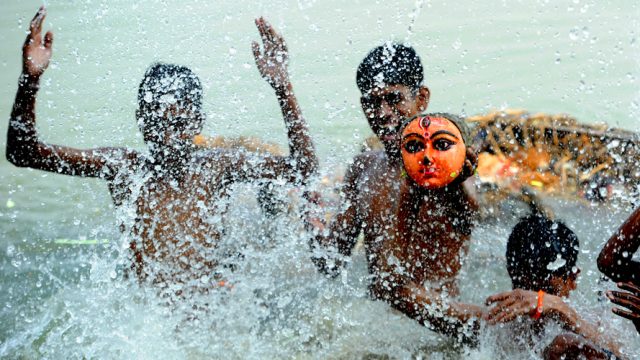Durga Puja is a time to celebrate with near and dear ones; soak in the festive atmosphere; enjoy the glitz and glamour of the themed pandals and beautiful idols. The rituals associated with Pujo are important of course, but a local would have seen them too many times and thus would find nothing out of the ordinary. However, for a visitor, the various religious rituals and functions are something unique.
A visitor would be mesmerised by the various rituals but not know of the name or why they are being performed. So, if you’re visiting Kolkata during the festival, fret not, here’s your Durga Puja lexicon:
Kolparombho or Bodhon
Kolparombho or Bodhon (purse your lips and pronounce the word) is held on the sixth day after Mahalaya aka Mahashashthi. It’s the day Maa Durga reaches the mortal world from Kailash, her heavenly abode, with her children in tow – Lord Ganesh, Lord Karthik, Devi Saraswati and Devi Laxmi. Maa’s face will be uncovered while devotees will celebrate the occasion with much pomp and dhak beats as it marks the deity coming alive. It’s time for the celebrations to begin! Head to any pandal or traditional house if you want to kick start your Durga Puja witnessing this event.
Kola Bou or Nabapatrika

The Kola Bou snan is held on Mahashaptami, or the seventh day after Mahalaya. The day starts with the ritual where a banana plantain with eight other plants is tied with yellow threads and the twigs of the Aparajita plant. It is then bathed and draped in the laal par shada saree (traditional red and white saree). The leaves are smeared with vermillion while various offerings are made. Then, the Kola Bou is placed on Lord Ganesha’s right. The place to see Kola Bou snan in Kolkata is at Babughat.
The nine plants or Nabapatrika signify the nine forms of Maa Durga – Goddess Brahmani (banana), Goddess Kalika (Colacassia), Devi Durga (turmeric), Goddess Kartiki (Jayanti), Goddess Shiva (wood apple), Devi Raktadantika (Pomegranate), Devi Sokrahita (Ashoka tree), Devi Chamunda (Arum plant) and Goddess Lakshmi (rice plant).
Historically, the Nabapatrika was worshipped by farmers for a good harvest but as Durga Puja gained popularity, this ritual was inducted into the ceremony.
Anjali
Anjali is common on the Pujo days. Ritualistically, anjali is divine offering. The most important of them all is the Pushpanjali which is held on Mahashtami, the eighth day after Mahalaya. Fresh flowers and bel leaves are handed by the priest to the followers. They repeat the mantra the priest chants and then the flowers are thrown at Maa’s feet. It’s done thrice overall. By the way, you’re supposed to do it without having consumed anything. This can be seen in any pandal, apartment Pujo or at a Bonedi Bari.
Kumari Pujo
Kumari Pujo is done on the auspicious day of Mahashtami. A young girl, who is yet to hit puberty, is worshipped. The young girl symbolizes the Kumari form of Maa and the best place to see this ritual is at Belur Math. The young girl is bathed in holy water, draped in a saree and adorned with jewellery. Priests then perform the same rituals as they would to Maa.
Sandhi Pujo
Sandhi Pujo is a special one that takes places at the juncture of Mahashtami and Mahanavami (ninth day post Mahalaya). It marks the exact moment when Maa Durga transformed into Devi Chamunda to kill Mahishasura’s two generals – Chand and Mund. 108 lamps are lit during the Pujo and the occasion is celebrated with dhaks. While it’s customary to perform an animal sacrifice, in these times, it’s symbolically done with vegetables. Head to one of the Bonedi Baris to see this beautiful ritual.
Dhunuchi Naach
The ‘dhunuchi’ is a typical clay pot, something like an incense burner, filled with burning dried coconut husks and aromatic ingredients. Men hold these in the hand and perform impromptu steps to the rhythm of dhaaks in front of Maa Durga. The steady rhythm, the heady incense and the smoke from the dhuuchi create a mystic ambiance. Gradually, this simple rite became a crowd puller as men took it to bragging heights – weaving complex rhythmic movements into the dance clutching more than one such clay pots. This is held on Mahanavami evening and can be seen best in the top pandals.
Sindoor Khela

The Sindoor Khela is another much-awaited event on Mahadashami, the last day of the festival. Translated into ‘playing with vermillion powder’, it’s actually an integral part of Durga Puja. Married women (not widows), often dressed in the traditional laar par shada saree, apply vermillion powder to Maa Durga and each other, apart from offering sweets to the Goddess. A very popular place to see this unique event is at Sovabazar Rajbari in North Kolkata or Ballygunge Cultural in the southern part of the city.
Visarjan

Visarjan is held after the main Pujo ends when the Goddess is immersed into the water so she can return to her heavenly abode. The Visarjan is held on Mahadashami or the last day of the celebrations. There are tearful farewells and a grand send off to Maa as she’s paraded around the locality and the city before she is finally taken to the ghat to be immersed. Find a place at Babughat to find yourself amidst all the action!
Bijoya
Bijoya Dashami is held after the Visarjan. This is the time when Maa Durga is on her way back to Mt Kailash and mortals are supposed to rejoice, seek blessings from elders, share the love and affection among equals and bless the ones who are younger.
See wbtourismpuja.in & wbtourism.gov.in for more details and download the Sharadotsav App by the Dept of Tourism available on Google Play Store.




